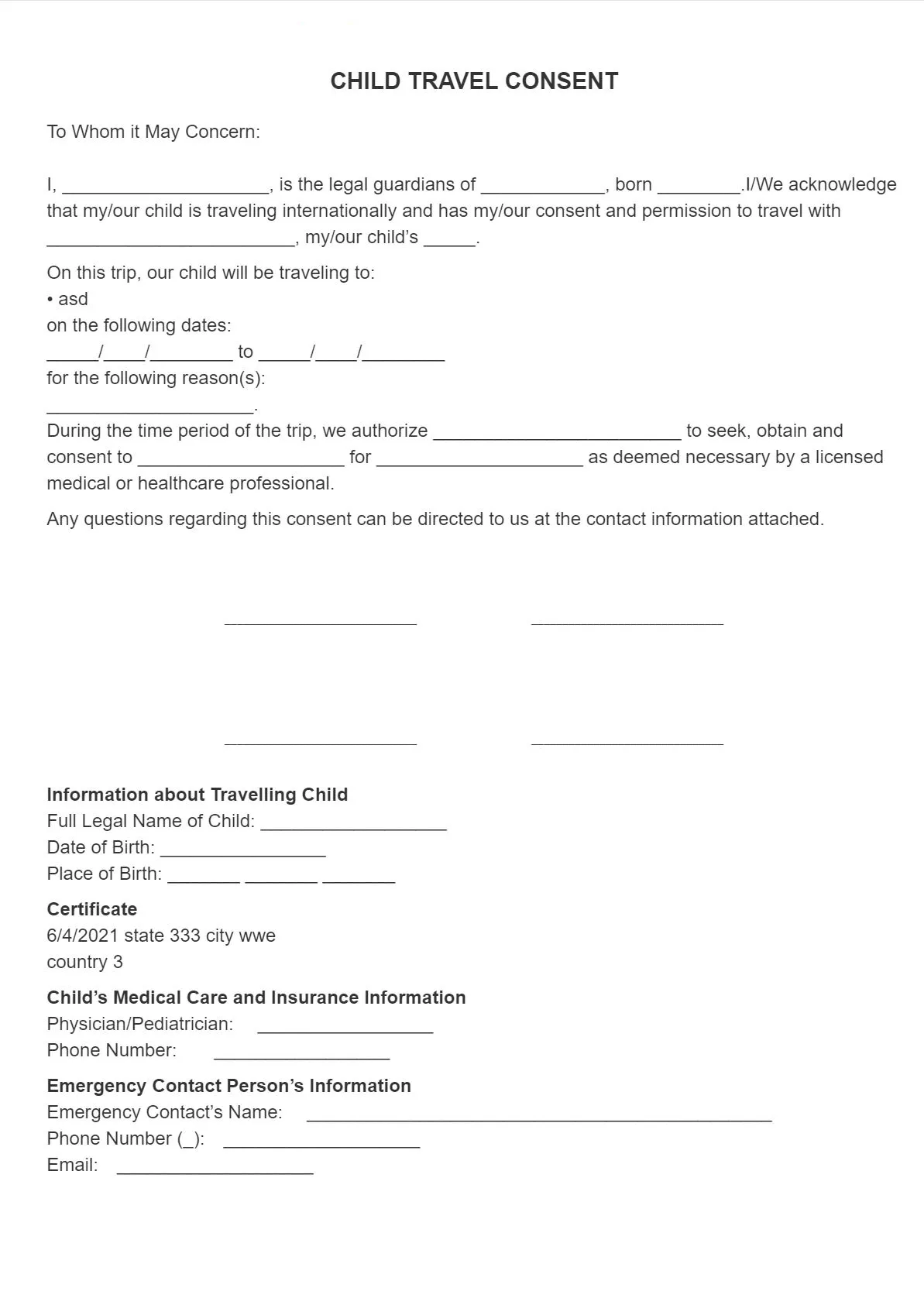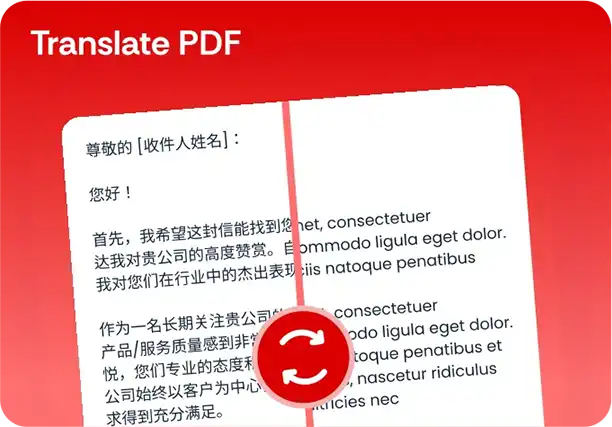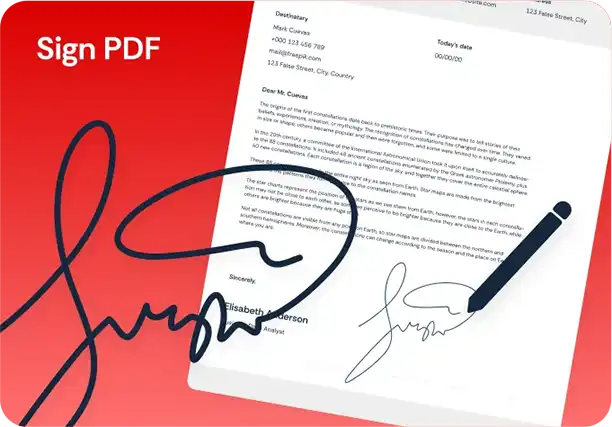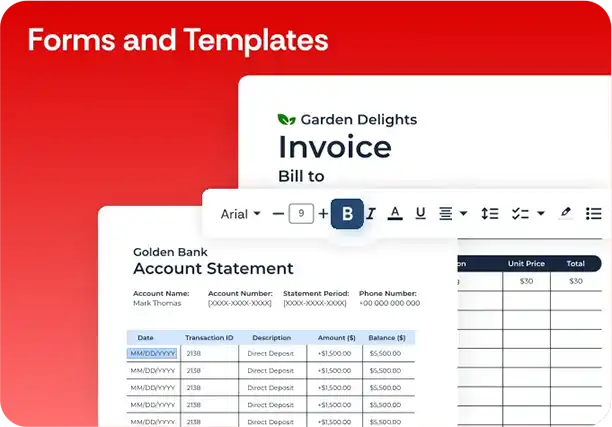Child Travel Consent Form Template
Stop searching and find out why people love the ease of creating beautiful and legally compliant Child Travel Consent Form with PDFSimpli.

Stop searching and find out why people love the ease of creating beautiful and legally compliant Child Travel Consent Form with PDFSimpli.


Pick from the colors and templates below
To Whom it May Concern:
I, ____________________, is the legal guardians of ____________,
born ________.
To Whom it May Concern:
I, ____________________, is the legal guardians of ____________.
To Whom it May Concern:
Guardian Information. We, _____ and _____, are legal guardians of _____.
Travel Consent. Child has permission to travel with _____.
Medical Authorization. We authorize necessary medical treatment.



A child travel consent form is a legal document proving that a child has received permission to travel, either alone or with an adult. Both parents, or the child’s legal guardian, usually need to sign the form. This document is also known as a parental consent form, minor travel consent form, travel permission letter or a travel consent letter for children traveling abroad.
In the United States, any minor children, including teens under 18, need to have a signed child travel consent form. The purpose of requiring parental consent is to prevent child trafficking and international child abduction. It’s not enough for adults to say they know the minor – even in the case of their own children. The adult must prove they have travel authorization from both parents.
There are many situations where a travel consent letter is essential. If you want to take your child on a trip alone, you would need a signed travel consent form from your spouse. This document is also required if your son or daughter is traveling in a group with teachers and classmates. Even grandparents, aunts, uncles and family friends need a parental consent form when accompanying a minor.
A child travel consent form is used to prove that you have parental authorization to travel with a minor. Parents can also use this form to authorize someone else to travel with their child, such as for field trips. Any family members, including grandparents, will need to show a correctly completed (and probably notarized) travel consent form before they’re allowed to leave the country with your child. These rules apply to flights, bus trips, cruises and even road trips to Canada or Mexico.
Having a valid child travel consent form can save you a lot of time and prevent considerable headaches when traveling internationally with a minor. Whether you’re traveling alone with your kids or letting them go on vacation with another relative, you need to fill out a travel consent form. This form is fairly easy, so it doesn’t take long to make your own.If you get stopped by Customs and Border Protection agents without a signed child travel consent form, it can have huge impact on your vacation plans. CBP agents may prevent minors from getting on a plane until you obtain valid permission. Certain countries may not allow you to enter their borders at all with your child unless you have a notarized travel consent form.
Most travel consent forms are short and simple. The main point of the document is to state that you, as the child’s parent, have provided consent and permission for your son or daughter to travel. The specific layout depends on whether your child is traveling with you or another person. Here are several important areas:
Name of parents: Your name and the name of the child’s other parent.Name of child: Your child’s full name as it appears on the birth certificate or passport.Child’s contact information: Child’s place of birth, date of birth and/or passport number.Contact information of both parents: Parents’ phone numbers, email addresses and street addresses.Name of responsible adult and relationship: Full name of person accompanying child. Mention if parent, grandparent, aunt, uncle, friend, teacher, etc.Information about travel arrangements: Whether child is traveling alone, with a parent, with relative or in a group.Emergency contact info: Name and phone number of person to contact in an emergency.Trip information: The dates your child will be traveling, airline route, city of origin, city of destination and reason for trip.Destination details: Where child is staying (address) at destination or places they’re visiting on field trip.Area for notary public: Empty space for notarizing the document.
1 What is a Child Travel Consent Form?
2 What is a Child Travel Consent Form used for?
3 Why should you use a Child Travel Consent Form?
4 How to write a Child Travel Consent Form?
5 How to fill out a Child Travel Consent Form with PDFSimpli in five steps?
6 Child Travel Consent Form frequently asked questions
6.1 Do I Need a Child Travel Consent Form To Travel With My Own Child?
6.2 Does a Child Travel Consent Form Need To Be Notarized?
6.3 Do I Still Need a Travel Consent Form If I Have Sole Custody?
When both parents are traveling with a child, there’s no need to use a consent form. If you’re traveling alone with your child, this form is not usually necessary for flights within the United States, though some airlines require it. For all international travel, U.S. Customs and Border Protection recommends bringing a child travel consent form signed by your spouse. Many countries (especially Canada) require parents traveling alone with a child to carry this form.
For domestic travel, notarizing a travel consent form isn’t required. When kids or teens travel to other countries (or return to the U.S. from other countries), government agents may request a notarized form. Because of this, it’s usually best to notarize the form just in case. This proves that the document is authentic and may accelerate your journey through the airport. Unaccompanied minors usually need a notarized form also.
In the case of parents who are divorced or separated, it’s generally a smart idea to obtain a signed travel consent document from the other person. Even if you have sole custody, the other parent likely has legal visitation rights. One exception to this rule is if you have a court order or separation agreement that specifically allows you to travel with your child. In this case, you would need to carry an original and certified copy of the court order.